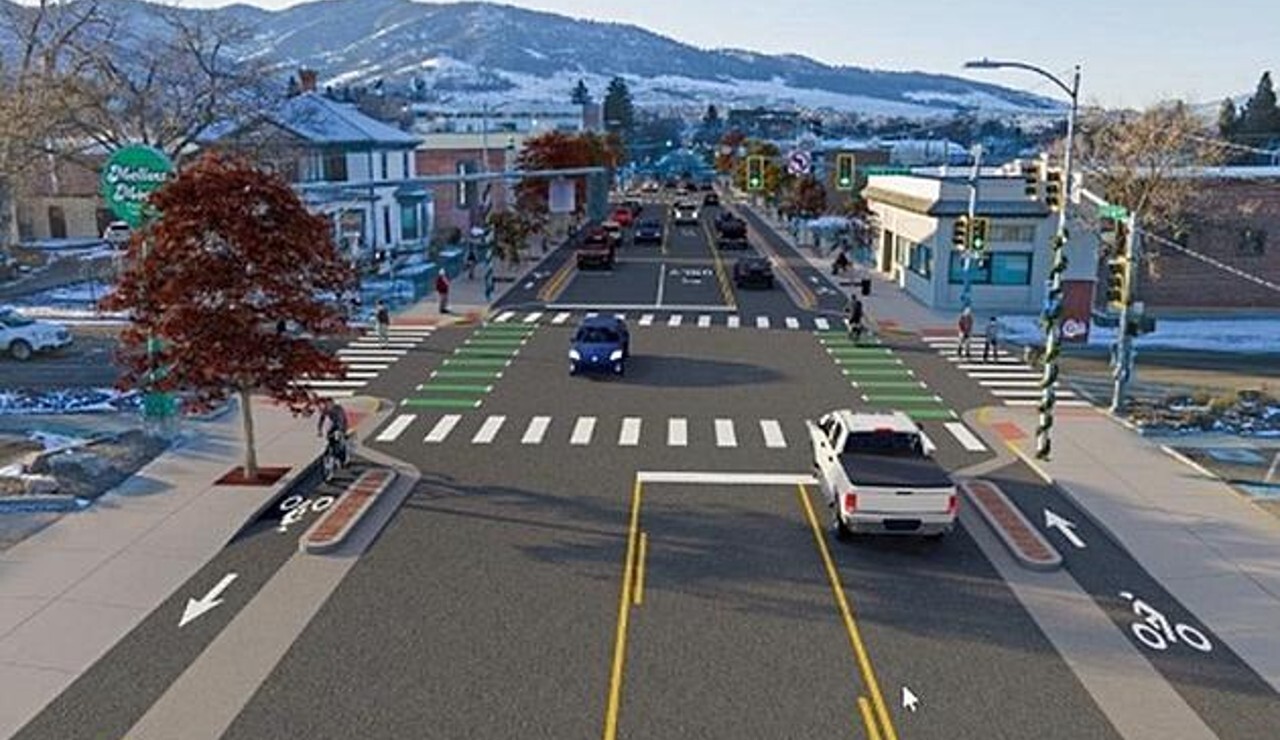MISSOULA - Too much parking or not enough? Added time for motorists or improved safety for cyclists? What about events at Washington-Grizzly Stadium, or busy days downtown?
The Missoula City Council will have to make a decision in the coming weeks on whether to sign off on changes to Higgins Avenue south of Broadway. Transportation officials and their allies in the biking community are recommending a reduction in lanes from four to three, with one travel lane in each direction and a center turn lane.
Aaron Wilson, the city's transportation manager, said no single solution proposed in the Downtown Master Plan checks all the boxes for Higgins Avenue — a corridor the plan envisions as a future “postcard” street with room for all modes of travel.
But advocates believe the tradeoffs recommended in the current plan accommodate all sides of the debate.
“We can't do everything. We can't do a design that accommodates everything everyone wants in the corridor,” Wilson said. “In all the measures we looked at, there are tradeoffs."
A slight traffic delay but improved safety
The City Council was set to vote on the issue Wednesday, but a mistake in the referral didn't state as much. As a result, council member Mike Nugent urged his peers to hold the issue in committee until proper notice was given on when a vote will occur.
Of all the alternatives initially proposed, transportation officials settled on one that would reduce Higgins from four travel lanes to three between Sixth Avenue and Broadway. It would also add separated bike lanes along the roadway.
The result would look similar to Higgins Avenue north of Broadway. While some parking would be lost south of Broadway with the changes, Wilson said the reduction would be minimal.

“Because of the narrow right-of-way, we're losing all the parking on just two blocks on the west side of Higgins between Fourth and Sixth,” he said. “Due to creative design on either end of this section, we're able to keep most of the parking between Sixth and Brooks.”
Wilson also defended the additions made to Beartracks Bridge during recent renovations. The bridge closed as a four-lane bridge and will likely open with two lanes, depending on the timeline of the Higgins project.
“We had to rehabilitate the bridge anyway. While we're proposing changes just to the striping over the bridge, we're not taking away any of that investment in that future capacity,” Wilson said. “If it's needed or if things change in our transportation system, we have the flexibility in that additional width.”
Wilson suggested a slight majority of the large public favors the project as proposed, including the addition of raised bike lanes, dedicated left turn lanes and shorter crossings at intersections.
However, businesses along Higgins Avenue were evenly split in their support, he said, with concerns ranging from increased congestion to loss of parking. At peak traffic hours, Wilson said a motorist would likely encounter around 1 minute of additional delay.
“One of the tradeoffs going from four lanes to three lanes with the volumes we see today will likely increase the delay during rush-hour traffic,” he said. “Our modeling showed an average of 50 seconds going from Broadway to Brooks, and some small increase in delay on the side streets as well. But we're increasing safety 24 hours a day versus the one hour each day with an additional delay.”
A range of opinions
While comments submitted online have voiced both support and concern for the project, public comments offered Wednesday questioned the project's need and the process in which it has played out.
One speaker suggested the plan caters almost exclusively to cyclists.
“We do seem to cater to bicycles in this town, and the vast majority of people drive cars,” the man said. “I think we need to focus on how the majority of people get around. This project doesn't really serve the vast number of Missoulians. It's really for a few.”

Scott Billadeau, owner of Liquid Planet, also questioned the outreach to businesses. He said the city only recently sought feedback from impacted businesses and the Missoula Downtown Association hasn't been willing to listen to business concerns.
He also disputed the city's claim that support among businesses was evenly split.
“There has only been recent outreach to us business owners downtown who are on Higgins. It literally only happened 30 days ago,” he said. “Now at the very end of the process are they coming to us. That's really upsetting that we're this far into the process and literally just now hearing about it.”
But Peter Walker Keleher, a member of the Missoula Parking Commission, a member of the Higgins Avenue project team and a former member of the Missoula Bike-Pedestrian Board, praised the project and its process.
“I think people are scared of change. We're dealing with a team that studies projects across the country. These are the conclusions they've come to, and they're extremely well thought out,” he said.
Only a few members of City Council have expressed support for the project at this stage in the hearing process. It's expected to vote on the plan early next month.
“Overall, I think people like this project. Being a people-oriented and destination design, there's an opportunity for Higgins to be that multi-modal transportation corridor envisioned in the Downtown Master Plan that provides a safe, accessible route for all modes and feels like a destination,” Wilson added. “We've focusing on people and not just moving cars. Having that destination feel is really important for the success of the corridor and downtown.”



